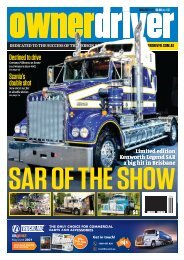Farms & Farm Machinery #401
Create successful ePaper yourself
Turn your PDF publications into a flip-book with our unique Google optimized e-Paper software.
News<br />
Images are taken by drone to generate a<br />
map of the area that needs spraying<br />
We don’t want<br />
people to think<br />
it’s a drone-based<br />
sprayer<br />
SPRAYER<br />
Sprayer manufacturer Hardi has taken a big step into the<br />
technological space, launching a selective spraying system,<br />
which it claims could reduce chemical use and costs by up<br />
to 90 per cent. Lincoln Bertelli reports<br />
Centimetre perfect<br />
. Hardi says that chemical use, labour and wastage can<br />
be reduced by up to 90 per cent with GeoSelect<br />
Hardi’s newest innovation, GeoSelect, marks the<br />
company’s “first step into genuine technology” with<br />
a software package that works in tandem with drone<br />
images to identify and spray exactly where weeds<br />
are on a paddock.<br />
It uses a “decoupled” structure, meaning the<br />
images are taken by drone before being processed<br />
quickly without loss of resolution and delivering a<br />
precise map of which areas require spraying.<br />
Multiple lightweight antennas, described as<br />
“rugged and waterproof”, are mounted along<br />
the sprayer’s boom to ensure precision to the<br />
centimetre when spraying, even factoring in<br />
boom deflection and weather conditions.<br />
Crucially, GeoSelect works with standard Hardi<br />
spray nozzles.<br />
GeoSelect was unveiled in Adelaide in July and<br />
Hardi Australia’s chief executive Bill Franklin said<br />
at the launch the technology had been the result of<br />
several years’ effort.<br />
“We don’t want people to think it’s a drone-based<br />
sprayer,” he said.<br />
“The drone is the means of capturing the<br />
image. GeoSelect is pure software. Our guys<br />
have written software to overcome barriers which<br />
existed previously.<br />
“It identifies the precise geolocation of target<br />
vegetation and records that, so you get full recording<br />
of every activity and it preserves the original spatial<br />
resolution.”<br />
Franklin said the decoupled structure, with<br />
imaging and spraying being separate, had numerous<br />
advantages that had not been obvious when Hardi<br />
first set out to create the software.<br />
“Some of those arise from knowing exactly<br />
what there is to spray before you’re in the paddock,”<br />
he explained.<br />
“When you’re there with a camera, you’ve got to<br />
drive past it before you know it is present.<br />
“By taking the images before then, we know<br />
exactly where the targets [are] and we know<br />
how many targets are in the field so we can<br />
thereby work out how much chemical we’ve<br />
got to take on.”<br />
Other advantages, Franklin said, included<br />
knowing in advance which areas did not require<br />
treatment and therefore saving on labour, fuel,<br />
ground compaction and machine depreciation.<br />
The company estimates that chemical use, labour<br />
and wastage can be reduced by up to 90 per cent<br />
with GeoSelect.<br />
In a field test run by Hardi, live data was processed<br />
with up to 5mm accuracy and a 99.7 per cent hit rate.<br />
Boom deflection can also be measured down<br />
to the nearest 0.1 degree and Franklin said this<br />
precision was crucial for GeoSelect’s success.<br />
“If you’re running a 48m boom or bigger you can<br />
get quite substantial deflection,” he said.<br />
“Where your traditional sprayer thinks your boom<br />
is compared to where it actually is might be something<br />
completely different.<br />
“GeoSelect measures that accurately – it has<br />
additional GPS sensors along the boom to give<br />
you precision and accuracy in terms of where<br />
the nozzles actually are at the point of firing.<br />
“When we showed it to our own sales guys to start<br />
with, they didn’t believe we could get the nozzle<br />
response times we are actually getting.<br />
“Latency in firing is automatically calculated, we<br />
can take in and consider other ambient measurements<br />
and metrics such as winds and cross-winds,<br />
and all of that is processed within the algorithm and<br />
10 <strong><strong>Farm</strong>s</strong> & <strong>Farm</strong> <strong>Machinery</strong>
















